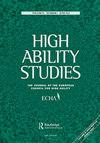相对年龄对认知任务的影响:以青少年国际象棋为例
IF 1.8
4区 教育学
Q2 EDUCATION, SPECIAL
引用次数: 10
摘要
相对年龄效应(RAE)已经在许多青少年和职业体育运动中得到证实。在这项研究中,我们假设年轻的国际象棋选手也会有RAE,他们通常参与复杂的认知任务,没有明显的身体要求。虽然在成年棋手中已经观察到典型的rae,但在本文中,我们希望主要关注青少年棋手。此外,我们还研究了rae在全国国际象棋锦标赛中的参与率和表现水平。因此,RAE是在一个复杂的认知任务中进行的,这个任务没有明显的身体要求,更具体地说,是在青少年国际象棋选手中进行的。数据分析:(1)5年期间(2009-2013)所有注册的比利时青年国际象棋选手和(2)2013年比利时青年锦标赛的参与者。结果表明,在过去的5年里,所有比利时青年国际象棋选手的总体RAE。出生在第一个出生日期四分位数的球员参加比赛的可能性显著更高(χ 2 = 10.21, p < 0.05;R =−。77, p < 0.01;W = .07),当年轻棋手出生在当年的最后四分之一时,参与的可能性就会降低。这些影响在8岁以下和10岁以下的儿童中最为突出。似乎还存在与绩效相关的RAE。Kolmogorov-Smirnov检验(p < 0.05)表明,在选拔年度的前几个月出生的球员在2013年比利时青年锦标赛各个年龄段的前10名球员中明显更多。本文章由计算机程序翻译,如有差异,请以英文原文为准。
Relative age effects in a cognitive task: A case study of youth chess
Abstract The relative age effect (RAE) has been demonstrated in many youth and professional sports. In this study, we hypothesized that there would also be a RAE among youth chess players who are typically involved in a complex cognitive task without significant physical requirements. While typical RAEs have been observed in adult chess players, in this paper we wanted to focus primarily on youth chess players. In addition, we also examined RAEs in both participation rates and performance levels in a national chess championship. Therefore, the RAE was examined in a complex cognitive task that has no significant physical requirements, more specifically among youth chess players. Data were analyzed (1) for all registered Belgian youth chess players over a 5-year period (2009–2013) and (2) for participants of the Belgian youth championship 2013. Results indicated an overall RAE among all Belgian youth chess players over the last 5 years. The likelihood of participation was significantly greater for players born in the first birth-date quartile (χ² = 10.21, p < .05; r = −.77, p < .01; w = .07) and the likelihood of participation decreased when youth chess players were born in the last quartile of the year. These effects were most prominent in the under-8 and under-10 year olds. There also appeared to be a performance-related RAE. Kolmogorov–Smirnov tests (p < .05) showed that players born in the first months of the selection year were significantly more often in the top 10 players for each age level of the Belgian Youth Championship 2013.
求助全文
通过发布文献求助,成功后即可免费获取论文全文。
去求助
来源期刊

High Ability Studies
Multiple-
CiteScore
4.80
自引率
11.10%
发文量
7
期刊介绍:
High Ability Studies provides a forum for scholars in a variety of disciplines associated with the development of human abilities to their highest level. It is a medium for the promotion of high ability, whether through the communication of scientific research, theory, or the exchange of practical experience and ideas. The contents of this journal are unique in reflecting concerns and recent developments in this area from childhood and across the whole life span in a variety of contexts. Far from being restricted to the traditional focus on high-level cognitive development, it also presents investigations into all other areas of human endeavour, including sport, technology, the arts, business, management and social relations.
 求助内容:
求助内容: 应助结果提醒方式:
应助结果提醒方式:


